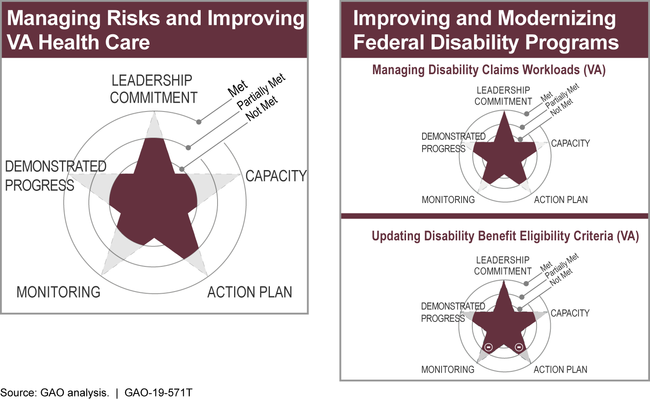Veterans Affairs: Sustained Leadership Needed to Address High-Risk Issues
Fast Facts
The Department of Veterans Affairs is in need of transformation and should address longstanding management challenges that we currently highlight on our High Risk List.
Since 2000, we have made more than 1,200 recommendations to improve management and operations at VA, and VA has implemented approximately 70% of them. Implementing the remaining recommendations could significantly improve VA’s operations and improve the care provided to the nation’s veterans.
In this testimony, we highlighted the need for VA to better manage risk to improve health care, focus on acquisition management, and modernize federal disability programs.

Highlights
What GAO Found
The Department of Veterans Affairs (VA) has longstanding management challenges. As a result, GAO added several VA programs to its High-Risk List. This list focuses attention on government operations that are most vulnerable to fraud, waste, abuse, or mismanagement, or in need of transformation. These include managing risks and improving VA health care, VA acquisition management, and improving and modernizing VA disability programs, including managing claims and updating eligibility criteria.
March 2019 High-Risk Report Ratings for High-Risk Areas Related to the Department of Veterans Affairs (VA)

Note: VA acquisition management was a newly designated high-risk area in 2019. As such, it was not rated on the five criteria in March 2019.
VA health care was designated high risk in 2015 due to concerns about VA's ability to ensure the cost-effective and efficient use of resources to improve the timeliness, quality, and safety of health care for veterans. GAO identified five areas of concern: (1) ambiguous policies and inconsistent processes; (2) inadequate oversight and accountability; (3) information technology challenges; (4) inadequate training for VA staff; and (5) unclear resource needs and allocation priorities. VA's efforts to address each of these areas have been impeded by leadership instability. However, since his July 2018 confirmation, Secretary Wilkie has demonstrated his commitment to address the department's high-risk designations. His actions to date have allowed the department to maintain its leadership commitment rating of partially met in GAO's 2019 High-Risk update. VA also partially met the action plan criteria. As of March 2019, it did not meet the other three criteria for removal from the High-Risk List (agency capacity, monitoring, and demonstrated progress). This is, in part, because GAO continues to have audit findings that illustrate that the five areas of concern have not been fully addressed. For example:
In a series of reports from 2012 through 2018, GAO found VA's wait time data unreliable for primary and specialty care as well as for care in the community. GAO also found that VA did not measure the full wait times that veterans experience in obtaining care across these settings.
In November 2017, GAO reported that VA medical center officials did not always conduct or document timely required reviews of providers when allegations of wrongdoing were made against them.
In April 2019, GAO found that VA's governance plan for modernizing its electronic health record system was not fully defined, potentially jeopardizing its fourth attempt at modernization.
In April 2019, GAO reported that VA's appraisal process for assessing medical center director performance relies heavily on a system with long-identified deficiencies that remain unaddressed, thus diminishing VA's ability to hold officials accountable.
In its 2019 High-Risk Report, GAO added VA acquisition management as a high-risk area in light of the department's numerous contracting challenges and the significant federal investment in serving veterans. To date, GAO has identified challenges in the following areas: (1) outdated acquisition regulations and policies; (2) lack of an effective medical supplies procurement strategy; (3) inadequate acquisition training; (4) contracting officer workload challenges; (5) lack of reliable data systems; (6) limited contract oversight and incomplete contract documentation; and (7) leadership instability. For example, as of May 2019, VA does not have updated acquisition regulations and officials expect to have a full update by 2021; a process which has been in place since 2011.
GAO designated improving and modernizing federal disability programs, including VA's program, as high risk in 2003. GAO identified two areas of concern related to VA: (1) managing disability claims workload and (2) updating disability benefit eligibility criteria. As a result of these concerns, veterans may not have their disability claims and appeals processed in a timely manner. GAO reported in March 2018 that VA is making a major effort to reform its appeals process by onboarding new staff and implementing new technology. However, its appeals planning process does not provide reasonable assurance that it will have the capacity to successfully implement the new process and manage risks. VA agreed with GAO's recommendation to better assess risks associated with appeals reform.
VA leadership has committed to addressing GAO's high-risk concerns and has launched several transformational efforts. For example, VA is currently implementing the Veterans Health Administration Plan for Modernization, a framework that aims to modernize the department, as well as the VA MISSION Act of 2018. This Act requires VA to consolidate programs that allow veterans to receive care outside VA. If successful, these efforts could be transformative for VA. However, such success will only be achieved through sustained leadership attention and detailed action plans that include metrics and milestones to monitor and demonstrate VA's progress. Sustained congressional oversight will also be essential.
Why GAO Did This Study
VA is responsible for providing benefits and services to veterans, including health care, disability compensation, and various types of financial assistance. In fiscal year 2019, VA received a total budget of $201.1 billion and a discretionary budget of $86.6 billion—the largest in VA's history—to carry out its mission. GAO, along with the VA Inspector General and other entities, continues to identify significant deficiencies in VA's governance structures and operations—all of which can affect the care provided to our nation's veterans.
This testimony focuses on the status of VA's efforts to address GAO's high-risk designations and open GAO recommendations in the following areas: VA health care, acquisition management, and disability claims workloads and benefit eligibility criteria, among other areas. It is primarily based on GAO's March 2019 high-risk update and a body of work that spans more than a decade.
Recommendations
Since 2000, GAO has made more than 1,200 recommendations to reduce VA's high-risk challenges, and VA has implemented approximately 70 percent. GAO will continue to monitor VA's progress in implementing the remaining open recommendations.
